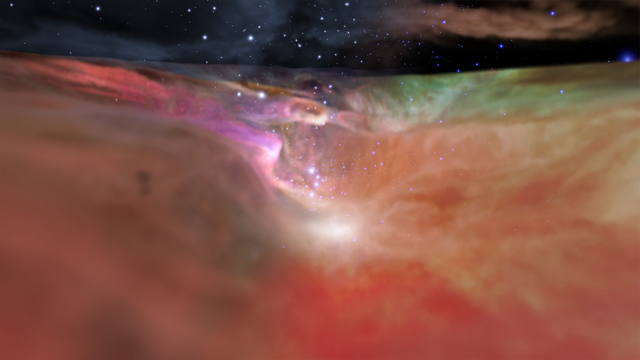
NASA has released a 3-D visualization of the Orion Nebula, which you should watch with the sound on (using headphones; don't be a monster) because in addition to being educational, the whole thing is incredibly soothing.
The Orion Nebula sits 1,300 light years from Earth. Using a combination of visible and infrared imagery from the Hubble and Spitzer space telescopes, specialists employed "Hollywood techniques" to give the video an artistic feel, according to the video. It's the "best and most detailed multi-wavelength visualization yet of the Orion Nebula," according to Space Telescope Science Institute experts cited in the video.
Experts at the annual American Astronomical Society meeting in Maryland on January 11 revealed that the nebula might contain two rogue planets that orbit each other, according to National Geographic.
"Being able to fly through the nebula's tapestry in three dimensions gives people a much better sense of what the universe is really like," visualization scientist Frank Summers, who led the team that developed the video, said in a NASA press release. "By adding depth and structure to the amazing images, this fly-through helps elucidate the universe for the public, both educating and inspiring...It's a really wonderful thing when they can build a mental model in their head to transform the two-dimensional image into a three-dimensional scene."
The 3-D model is scientifically a close likeness to the contents of the actual nebula. You can see our own Milky Way galaxy before floating over to the part of the nebula where baby stars are formed. The radiation and the heat from the nebula's central stars make everything appear extra-luminous, though perhaps that's down to one of the unspecified "Hollywood techniques."
The Orion Nebula has plenty of visible light, but the infrared technology allows you to also see the layers of the nebula that aren't as hot and bright—the light there has longer wavelengths, as opposed to the shorter ones we can detect with the naked eye. The video shows both "wispy bow shocks" (pile-ups of hot material caused by super-fast stars shooting through space, like how water appears to pile up in front of the bow of a boat) and "tadpole-shaped proplyds" (flattened disks that might one day be smoothed into round planets).
"Looking at the universe in infrared light gives striking context for the more familiar visible-light views," visualization scientists Robert Hurt said in the press release. This movie provides a uniquely immersive chance to see how new features appear as we shift to wavelengths of light normally invisible to our eyes."
Enjoy.
Uncommon Knowledge
Newsweek is committed to challenging conventional wisdom and finding connections in the search for common ground.
Newsweek is committed to challenging conventional wisdom and finding connections in the search for common ground.
About the writer
Kastalia Medrano is a Manhattan-based journalist whose writing has appeared at outlets like Pacific Standard, VICE, National Geographic, the Paris Review Daily, ... Read more
To read how Newsweek uses AI as a newsroom tool, Click here.








